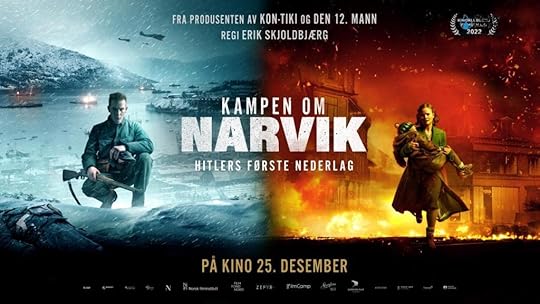They Were Giants
 After the rape of Ann Sheridan’s character by a German soldier, Resistance leaders led by Errol Flynn plan revenge in Edge of Darkness.
After the rape of Ann Sheridan’s character by a German soldier, Resistance leaders led by Errol Flynn plan revenge in Edge of Darkness.I’m working on a new book idea involving World War II, and two motion pictures I’ve watched recently on Netflix tangentially touch on my topic.
Narvik, made in 2021, depicts Norwegian civilians in the town of Narvik who watch the Germans march in as occupation begins in 1940. But they won’t accept life under Nazi rule, which leads to an epic battle that marks what came to be known as Hitler’s first military defeat. Fictional characters—Gunnar and Ingrid Tofte—form the emotional core of this real-life and very true-to-history story. He’s a member of the Norwegian army and his company takes to the hills after German occupation, while she’s trapped in town and serves as an interpreter between the occupiers and town officials.
 Number 24, a Norwegian production, shines devastating light on Nazi occupation as seen through the eyes of Gunnar Sønsteby.
Number 24, a Norwegian production, shines devastating light on Nazi occupation as seen through the eyes of Gunnar Sønsteby.The other and more recently made movie, Number 24, relates the true story of the most successful Resistance fighter of the Norwegian occupation, Gunnar Sønsteby, a young accountant so nondescript in appearance that the Germans don’t consider him a threat—until continued Resistance activities finally put him in the crosshairs. Through meticulous planning and single-minded purpose, he becomes the key Resistance leader in Oslo and an MI-6 operative for the British government, codenamed “Number 24.” The first half of Number 24 is so unrelentingly tense as Sønsteby tries to evade capture that I didn’t think I’d make it through the next minute, and the second half, full of redemption as Sønsteby begins a vengeance campaign to take out top Nazis, feels better than it probably should as one after another they’re gunned down without mercy.
Both pictures serve as reminders about the brutality of the Nazi empire, and both put me in mind of one of my favorite Errol Flynn pictures, Edge of Darkness, made in 1942 and released early the next year with the war very much in doubt from an Allied perspective. Edge of Darkness also tells a story of the Norwegian Resistance, this time in the fishing village of Trollness. And while much of it was shot in the Burbank studio and on backlots, with the northern California town of Monterey filling in for exteriors, Warner Bros. managed to accurately capture life 5,000 miles away in a country forced to live under the swastika. Imagine a 1943 picture that served up the Norwegian heroine raped by a German soldier; a sympathetic Norwegian woman attracted to a different, sympathetic German soldier; townspeople forced to dig their own graves prior to their execution; and a battle of annihilation that wipes out not only the Germans but most of the villagers.
In all three pictures, the Germans get their comeuppance, and what a triple feature these three would make. Each rings true to an overlooked aspect of history, even though their production spanned 82 years. Enough attention doesn’t get paid to Norway, which—while tucked away off the beaten path of the European war—played a major role in its evolution. Norway was of strategic importance for its iron ore, as shown in Narvik, and the country saw successful raids by British commandos soon after the occupation began, raids that drove Hitler crazy as did the revolt in Narvik. He became so obsessed with what he felt was a looming British invasion of Norway that he stationed 350,000 troops there for the duration of the war—troops that were not therefore available to stem the tide when the Allies invaded France in June 1944.
 Another Norwegian release captures the heroism of the Resistance during the epic 1940 battle for the port of Narvik.
Another Norwegian release captures the heroism of the Resistance during the epic 1940 battle for the port of Narvik.The question “What’s the price of freedom?” is both spoken and unspoken in each of these films. You’re either occupied by a foreign power or you’re free. The principals in all three choose to fight for their freedom and do it in ways true to the individual. A scene in Narvik shows Norwegian soldiers, who have just taken a hill from the Germans with the help of French allies, pulling down a Nazi flag and running up the Norwegian colors. It’s a very Edge of Darkness moment and mirrors a scene when Ann Sheridan takes aim with a rifle and shoots a Nazi who’s trying to raise the swastika over her town. “Free Norway!” Judith Anderson shouts into the telephone to Nazis at one point during the Trollness revolt. And when during a Resistance meeting one of the plotters thinks about how their work will be remembered, he growls that history will proclaim, “They were giants in Trollness!”
Oh my God, do I find such stories thrilling! I’m grateful that these two recent productions have focused on the Norwegian Resistance, with both Number 24 and Narvik benefitting from Norwegian productions, actors, and exteriors. This is Norway proudly reclaiming its history, a rich, heroic history that the world needs right now as right-wing authoritarianism threatens various points around the globe. The message of all three movies is singular and compelling: People who have lived free want to remain free and will prove unwilling to settle for others making decisions for them.
 Edge of Darkness: The final, seemingly doomed assault on German machine gun emplacements by the Resistance fighters of Trollness.
Edge of Darkness: The final, seemingly doomed assault on German machine gun emplacements by the Resistance fighters of Trollness.



